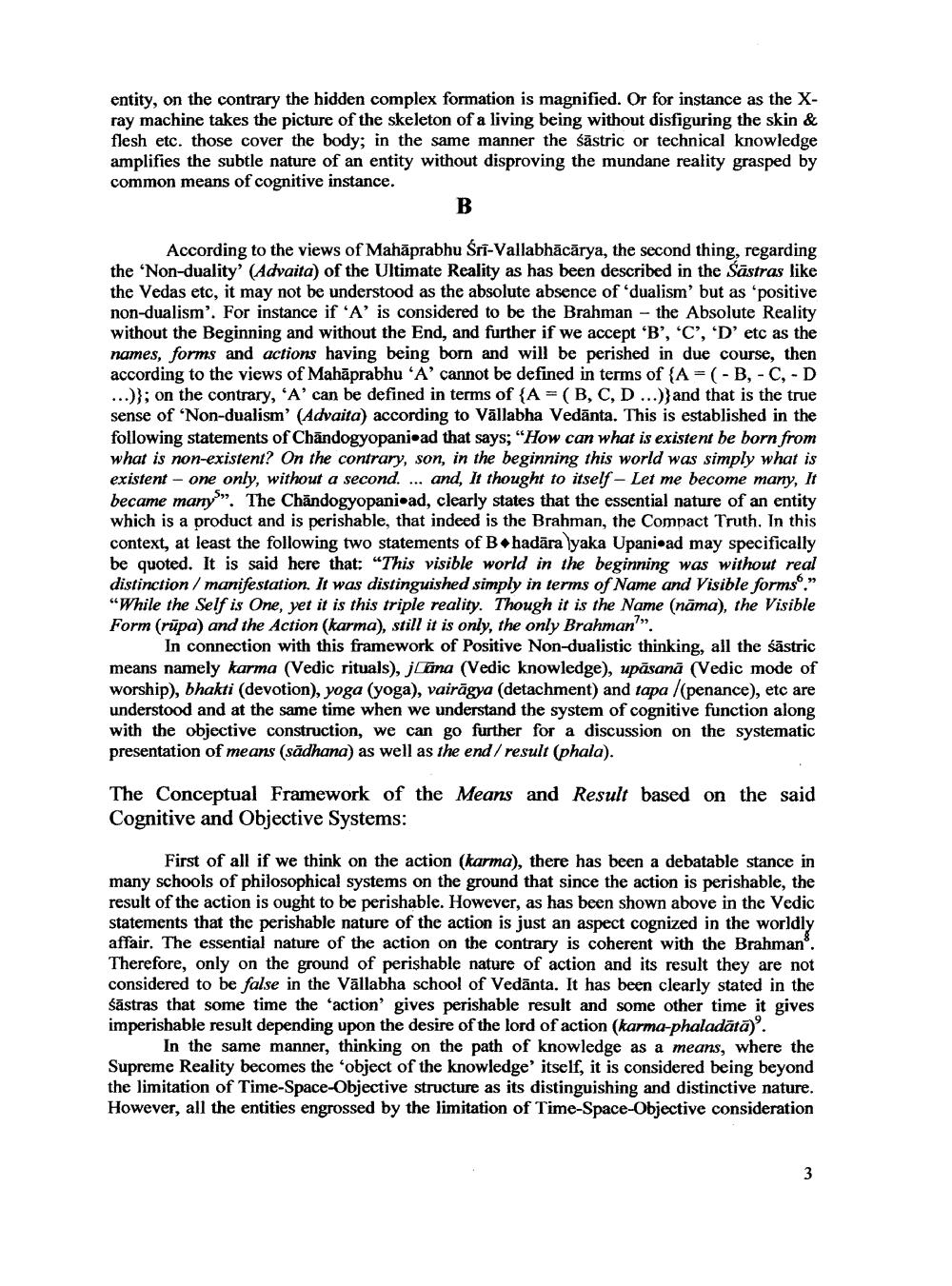________________
entity, on the contrary the hidden complex formation is magnified. Or for instance as the Xray machine takes the picture of the skeleton of a living being without disfiguring the skin & flesh etc. those cover the body; in the same manner the Šāstric or technical knowledge amplifies the subtle nature of an entity without disproving the mundane reality grasped by common means of cognitive instance.
B
According to the views of Mahāprabhu Sri-Vallabhācārya, the second thing, regarding the 'Non-duality' (Advaita) of the Ultimate Reality as has been described in the Sāstras like the Vedas etc, it may not be understood as the absolute absence of dualism' but as 'positive non-dualism'. For instance if 'A' is considered to be the Brahman - the Absolute Reality without the Beginning and without the End, and further if we accept 'B', 'C', 'D' etc as the names, forms and actions having being born and will be perished in due course, then according to the views of Mahāprabhu 'A' cannot be defined in terms of (A= (-B, -C, -D ...)}; on the contrary, 'A' can be defined in terms of (A = (B, C, D ...))and that is the true sense of 'Non-dualism' (Advaita) according to Vallabha Vedānta. This is established in the following statements of Chandogyopani.ad that says; “How can what is existent be born from what is non-existent? On the contrary, son, in the beginning this world was simply what is existent - one only, without a second. ... and, it thought to itself - Let me become many, It became many". The Chăndogyopani-ad, clearly states that the essential nature of an entity which is a product and is perishable, that indeed is the Brahman, the Compact Truth. In this context, at least the following two statements of Bhadāra yaka Upani.ad may specifically be quoted. It is said here that: “This visible world in the beginning was without real distinction / manifestation. It was distinguished simply in terms of Name and Visible forms." "While the Self is One, yet it is this triple reality. Though it is the Name (nāma), the Visible Form (rūpa) and the Action (karma), still it is only, the only Brahman'".
In connection with this framework of Positive Non-dualistic thinking, all the śāstric means namely karma (Vedic rituals), jana (Vedic knowledge), upāsanā (Vedic mode of worship), bhakti (devotion), yoga (yoga), vairāgya (detachment) and tapa /(penance), etc are understood and at the same time when we understand the system of cognitive function along with the objective construction, we can go further for a discussion on the systematic presentation of means (sādhana) as well as the end/result (phala).
The Conceptual Framework of the Means and Result based on the said Cognitive and Objective Systems:
First of all if we think on the action (karma), there has been a debatable stance in many schools of philosophical systems on the ground that since the action is perishable, the result of the action is ought to be perishable. However, as has been shown above in the Vedic statements that the perishable nature of the action is just an aspect cognized in the worldly affair. The essential nature of the action on the contrary is coherent with the Brahman Therefore, only on the ground of perishable nature of action and its result they are not considered to be false in the Vallabha school of Vedānta. It has been clearly stated in the Šāstras that some time the action gives perishable result and some other time it gives imperishable result depending upon the desire of the lord of action (karma-phaladātā).
In the same manner, thinking on the path of knowledge as a means, where the Supreme Reality becomes the 'object of the knowledge' itself, it is considered being beyond the limitation of Time-Space-Objective structure as its distinguishing and distinctive nature. However, all the entities engrossed by the limitation of Time-Space-Objective consideration




